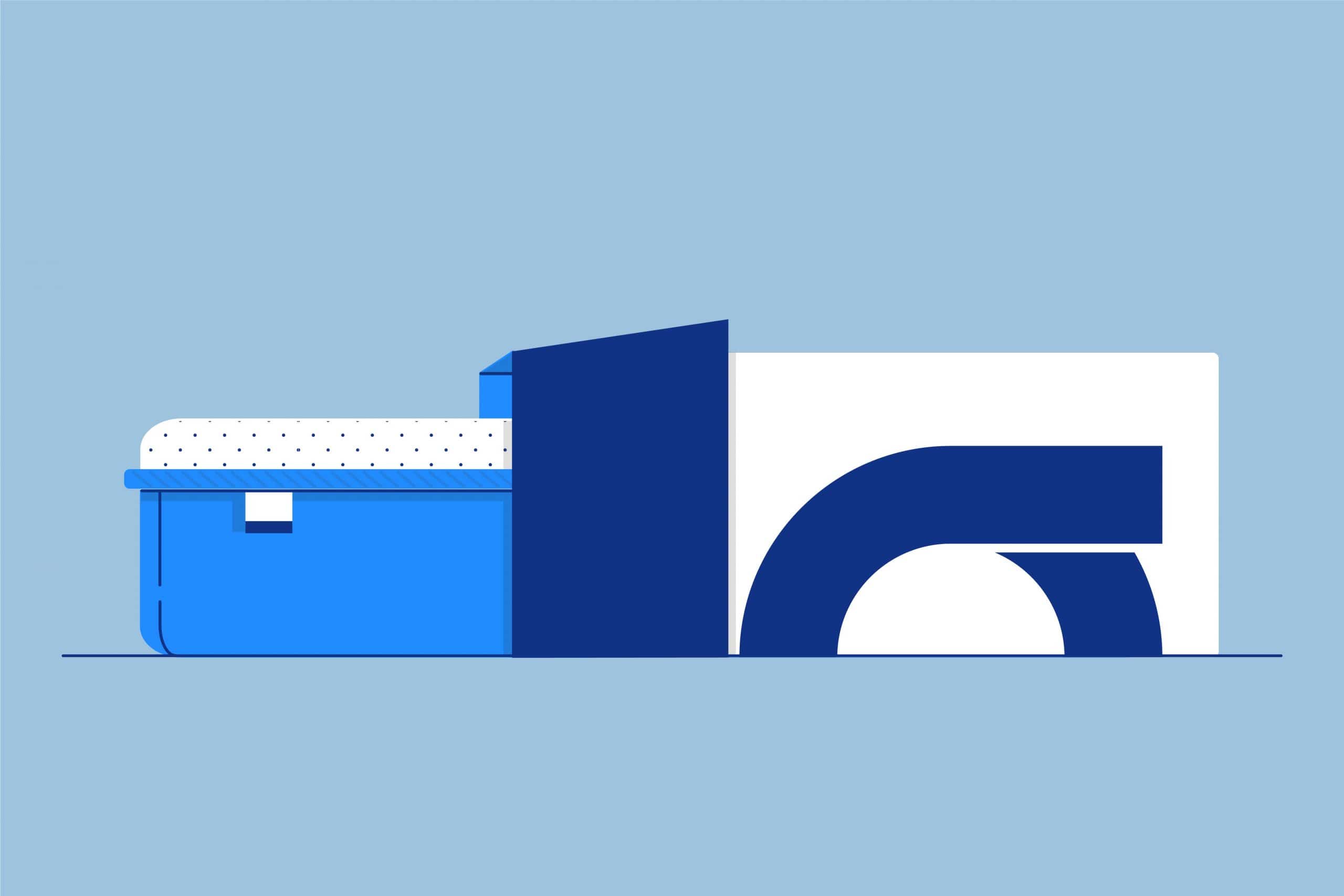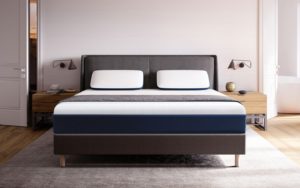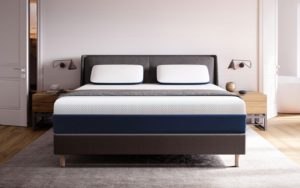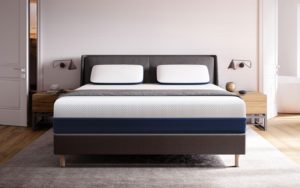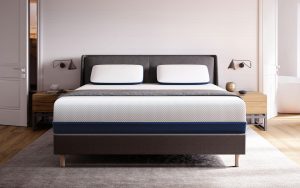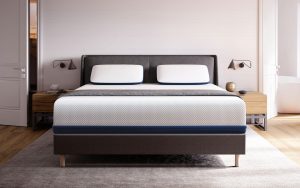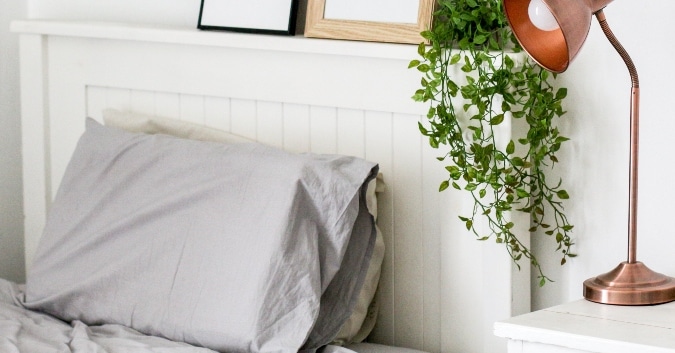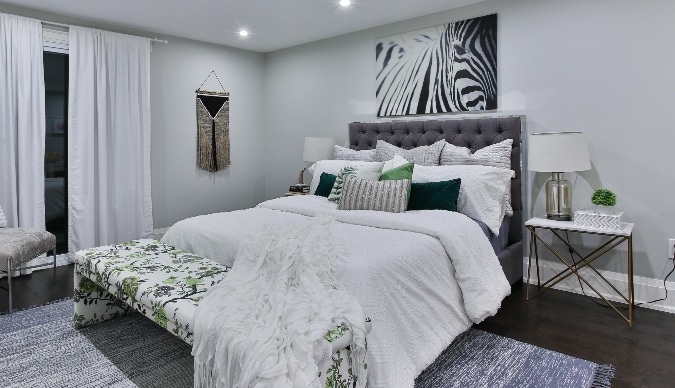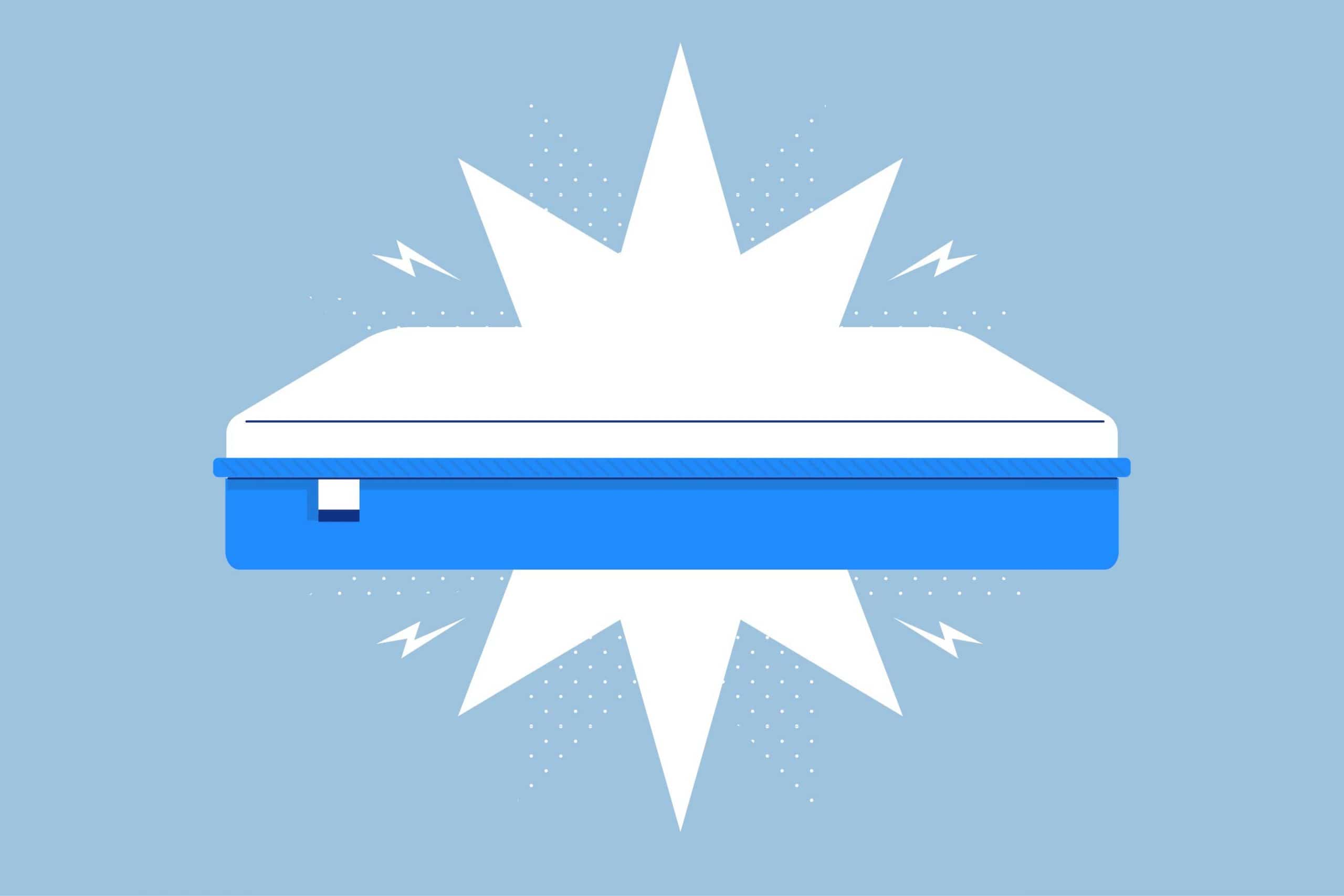You probably found this article because someone you know just got a mattress delivered to their house in a small box and you’re wondering…is that really a thing? Yes, it is! And it’s more than just a passing trend.
What is a Mattress in a Box?
We can’t talk about beds in a box without talking about the ubiquitous foam mattress— since 2006 when the first bed in a box was invented (by a company called Bed in a Box, of course), memory foam has only risen in popularity. That’s because memory foam lends itself well to being compressed, rolled, and stuffed in a box.
Beds in a box were born out of the need for customers to try out a mattress in their own home before committing to it. Instead of trekking to the nearest mattress store (or stores) and trying out dozens of beds for a few minutes each, you can now buy a bed online, get it shipped to your house, try it in your own room with your own bedding, and even return it for a full refund within a certain time period.
Best Mattresses In A Box
Quick Guide: A 30-Second Summary
| Amerisleep’s Firmest Mattress | Amerisleep AS1 |
| Best Mattress for Back Pain | Amerisleep AS2 |
| Best Mattress Overall | Amerisleep AS3 |
| Amerisleep’s Medium-Soft Mattress | Amerisleep AS4 |
| Best Mattress for Heavy Sleepers | Amerisleep AS5 |
1. Amerisleep AS1
- Amerisleep’s firmest model appeals to both back and stomach sleepers seeking a very firm bed
Not only is the AS1 the firmest, but it’s also the shortest and only two-layer mattress Amerisleep sells. For those seeking a notably firm bed, the AS1 is perfect for you. Like all other Amerisleep mattresses, the AS1 has a lightweight, breathable cover designed to regulate your temperature and boost deeper sleep. The AS1 is one of Amerisleep’s best mattresses for stomach and back sleepers but is too firm for side sleepers.
As we mentioned, the AS1 has two layers: a 2-inch Bio-Pur® comfort layer followed by 8 inches of Bio-Core® support foam.
When you lay on the AS1, the 2 inches of Bio-Pur® contour and mold to your body, but doesn’t allow for too much sinkage as it’s only 2 inches thick. What gives this bed it’s substantially firm feel in comparison to Amerisleep’s other beds is its lack of transition layer; right below the soft Bio-Pur® is firm Bio-Core®. You sink ever so slightly into the memory foam layer, but end up hitting the firm Bio-Core® below, providing solid support. If you’re somebody with pain, the AS1 may feel too firm, and the lack of zoned technology may not be ideal. The best firm mattress for pain would be Amerisleep’s next-firmest model, AS2.
Quick Summary:
- Amerisleep’s only 2-layer mattress offers a notably firm feel
- Lack of zoned support technologies makes this bed a poor choice for those with chronic pains
- Virtually zero motion transfer due to the firmness and foam
- Best for stomach and back sleepers but too firm for side sleeping
2. Amerisleep AS2
- Medium-firm model appeals to stomach and back sleepers who need slight cushioning
The medium-firm AS2 appeals to heavy sleepers who like a firmer surface, sleepers with back pain, or back and stomach sleepers. Business Insider even ranked the AS2 as their number one recommended mattress for back pain sufferers.
Each layer of the AS2 does something different for the overall support and feel of the bed. The top 2-inch layer of breathable Bio-Pur® gives you a soft place to rest. Below the Bio-Pur® is the Affinity transition layer with Surface Modification Technology (SMT). This three inch-layer has HIVE® technology, which adapts to your changing positions during the night, supporting you where you need it most.
The seven-inch Bio-Core® layer reinforces the softer layers above it and extends the life of the mattress beyond the average 7-8 years for memory foam beds.
Quick Summary:
- Affinity transition layer buffers between Bio-Core® and Bio-Pur® layers for extra support
- HIVE® technology relieves pressure points and dissipates heat
- Medium-firm feel gives stomach and back sleepers slightly more cushioning than the AS1
- Limited motion transfer thanks to the advanced open-cell foam
3. Amerisleep AS3
- Amerisleep’s best-selling mattress appeals to side sleepers, combo sleepers, and couples
The AS3 is the customer favorite thanks to its balanced medium-feel. If a bed-in-a-box brand only makes one mattress, usually it’s a medium-feel because that firmness appeals to side sleepers and combination sleepers, and these are the two most popular sleeping positions. Hence, a medium mattress appeals to the widest audience.
Medium mattresses work well for couples, too, since they are evenly soft and supportive, two things most consumers want in a mattress.
The AS3 has three inches of Bio-Pur® layer (one more inch than the AS2), so it’s a bit softer and more contouring for side and combination sleepers. The two-inch thick Affinity layer is followed by seven inches of sturdy Bio-Core®. The responsive Bio-Pur® layer limits motion transfer so you won’t feel the shifting movements of your partner during the night.
Quick Summary:
- Three inches of Bio-Pur® create a comfortable, cool sleeping surface
- Has a balanced medium firmness ideal for side and combination sleepers
- Bio-Core® extends the life of the mattress
- Adjusts to your sleeping position while relieving pressure points
4. Amerisleep AS4
- Medium-soft firmness appeals to side and combo sleepers who need extra cushioning
Like the AS3, the medium-soft Amerisleep AS4 is marketed to side and combination-sleepers, but it works well for anyone who likes slightly more give with an equal amount of support. Even though the AS4 is softer than the AS3, sleepers shouldn’t feel like they are sinking down into the bed and throwing their bodies out of alignment.
The AS4’s Bio-Pur® comfort layer is four inches thick— most brands only use 2-3 inches of foam for their comfort layer, so this model provides an extra bit of cushioning other memory foam beds don’t. The one-inch Affinity layer with HIVE® below the Bio-Pur® keeps sleepers feeling “lifted” on the mattress while adjusting to their changing positions. A durable 7-inch Bio-Core® layer rounds everything out.
Quick Summary:
- Medium-soft offers more padding and plush support for side-sleepers
- Minimizes pressure points so you don’t wake up in pain
- Bio-Core® layer keeps you lifted and supported without sinking
- HIVE® technology prevents misalignment and stiffness
5. Amerisleep AS5
- Amerisleep’s best mattress for heavy sleepers, its softness appeals to side and back sleepers alike
The AS5 is Amerisleep’s softest mattress and also their best mattress for heavy sleepers. The AS5 has an extra layer of material in it no other mattress has, which makes it suitable for sleepers over 250 pounds. This extra material, Active Flex, is a responsive poly-foam in place to prevent you from sinking too far in the mattress. It gives the bed a bit of bounce and prevents you from feeling “stuck” in the bed.
The AS5 has a similar makeup to the AS3, containing 3 inches of Bio-Pur®, 2 inches of Affinity and HIVE® technology, and 7 inches of Bio-Core®. But again, what sets this bed apart is its inclusion of Active Flex directly underneath the layer of Bio-Pur®. When you sleep on the AS5, the top layer of Bio-Pur® will contour to you, while the Active Flex below keeps you lifted “on top” of the mattress, rather than cradled within; this is exactly what heavy sleepers need in a mattress to prevent uncomfortable sinkage.
Quick Summary:
- Amerisleep’s best bed for sleepers over 250 pounds
- Equipped with Active Flex to prevent uncomfortable sinkage
- HIVE® technology promotes healthy sleeping positions and proper alignment
- Best for side and back sleepers, but never stomach sleepers
Benefits of Amerisleep’s Mattresses in a Box
Amerisleep might seem like just another bed-in-a-box online mattress retailer, but our unique foams and eco-friendly manufacturing sets us apart from the others. Most bed-in-a-box brands only make one or two models in the medium to medium-firm range. We offer five different firmness options with varying foam layers; each mattress is built to offer a customizable experience for every type of sleeper.
Bio-Pur® Foam
Bio-Pur® is unlike other comfort foams in the bed-in-a-box market because it’s partially plant-based, indicating fewer off-gassing odors. All memory foam is made using petroleum, a nonrenewable resource that can create an off-gassing odor when the mattress is unboxed. To offset these concerns, Amerisleep replaces a fraction of the petroleum in their foam with castor oil, a more sustainable and eco-friendly oil.
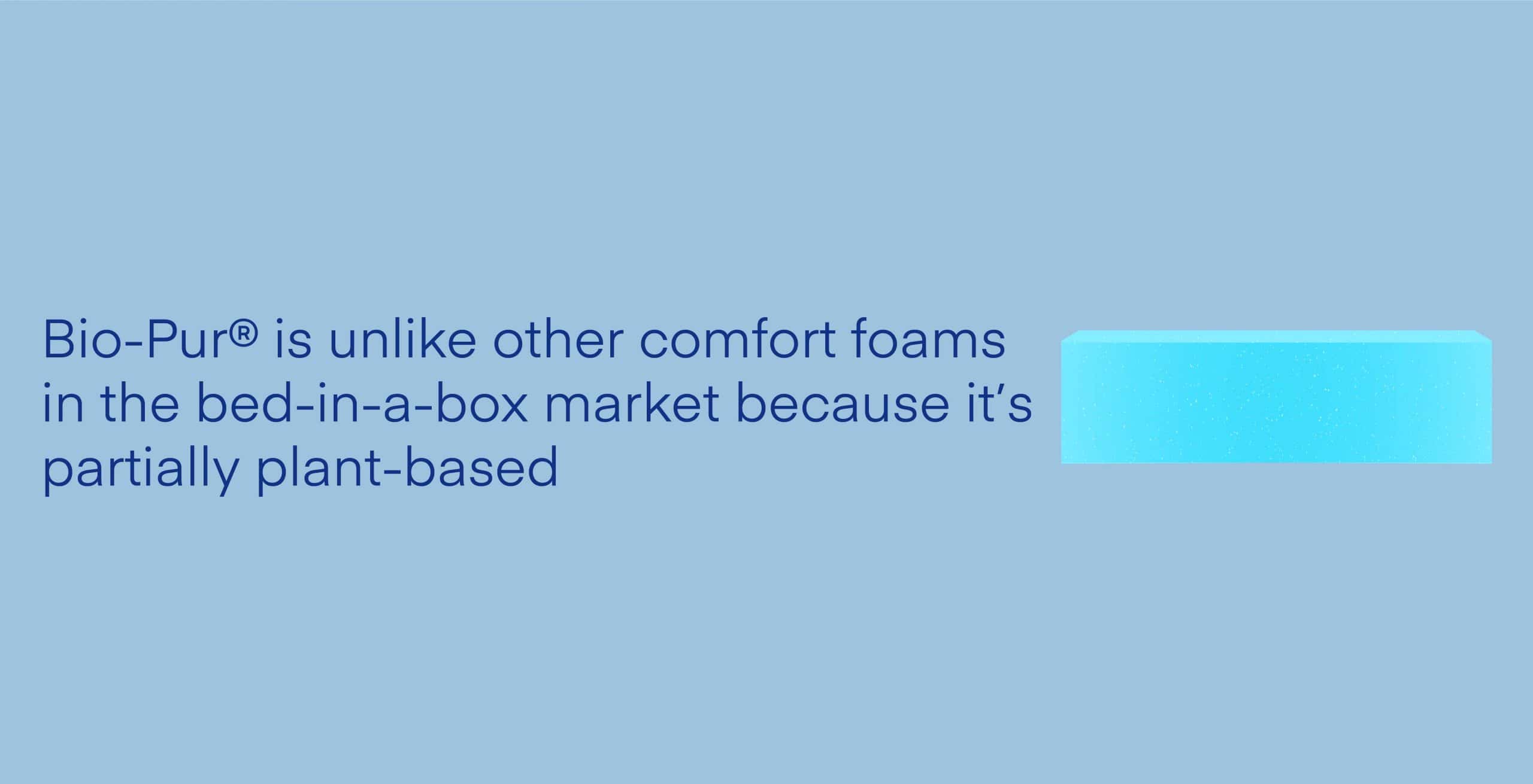
Bio-Pur® has an advanced open-cell construction, too, meaning there are more air channels between the foam particles. This translates to a cooler, more responsive mattress. In fact, Bio-Pur® is five times more breathable and retains its shape ten times faster than memory foam.
Affinity Layer with HIVE® Technology
The Affinity Layer with HIVE® is Amerisleep’s transition layer, meant to buffer between the softer comfort layers above it and the stiffer base layer below it. HIVE® stands for Harnessing Intelligent Ventilation and Energy, which describes exactly what this layer does. The Affinity layer is covered with hexagonal-shaped cutouts grouped closer together where you need more support (in the head, back, and feet) and farther apart where you need more pressure-relief (at the shoulders and hips).
The Surface Modification Technology of this layer adjusts to your sleeping position during the night, so you never feel stuck, trapped, or stiff. In other words, the mattress should feel the same no matter your position. As you can imagine, this layer improves motion isolation as well, so you don’t need to worry about bouncing around or falling off the mattress.
Bio-Core® Foam
The Bio-Core® layer is in every Amerisleep mattress. Like the Bio-Pur®, it’s manufactured using eco-friendly VPF. Even though this layer is made of foam, it’s highly supportive— in fact, it’s the reason Amerisleep can provide a longer warranty than most brands (20 years). It extends the life of your mattress and keeps the softer layers above it from sagging or sinking.
No-Risk, 100-Night Sleep Trial
Like most bed-in-a-box brands, Amerisleep offers a sleep trial so customers can try out their bed for a number of nights before deciding to keep it. They recommend you try out the mattress for at least 30 nights before initiating a return, and you can return it any time after that within 100 nights.
If you decide not to keep the bed after 30 nights, Amerisleep will help you donate your mattress and issue a full refund (with a donation receipt)— no re-packing your mattress and shipping it back.
Backed by a 20-year Warranty
The mattress industry’s standard warranty length is 10 years, and since most mattresses last for about 7-10 years anyway, this accounts for any defects or issues that may come up while the customer owns the mattress. Amerisleep offers 10 years longer than the industry standard because we are that confident in our beds’ durability.
Most mattress warranties cover the same manufacturing defects, although the specifics differ from brand to brand. Most companies cover sagging of 1 inch or more, but at this point, the mattress is already beyond uncomfortable and may be causing significant pain. Amerisleep covers sags when they reach ¾ of an inch deep.
The warranty also covers broken cover zippers, undone seams, and other defects not caused by normal use.
Amerisleep’s mattress warranty is prorated, meaning it’s split into two time periods wherein the responsibility to pay for repairs falls to the customer after a certain time. During the first ten years of the warranty, customers can get their mattress replaced or repaired by Amerisleep at no extra cost. After the first ten years, customers will pay 50% of the original cost for a replacement or a certain percentage of repair costs, as well as shipping.
All mattress warranties specify the type of foundation customers need to use with their mattress—if used on an incorrect or incompatible foundation, the customer risks voiding the warranty.We recommend using our mattresses on a solid base, such as a platform bed (not box springs). If you are using a slatted base, the slats should be no more than 3 inches apart.
How Do I Set Up My Mattress in a Box?
A basic bed in a box is compressed and rolled using a special machine. It is usually made of some kind of foam: memory foam, poly-foam, latex foam, and so on. Other mattress types can be shipped in a box as well, such as hybrids (50% foam, 50% coils), but this practice is not as common. Innerspring beds have thick coil support layers, which do not do well when compressed and rolled by a machine.
When your bed in a box arrives, you simply have to cut open the package and carefully slice into the vacuum-sealed plastic encasing the mattress. As soon as you let the air out of the vacuum-sealed bag, the mattress will begin to expand. Most companies recommend letting the mattress expand and air out for about 24 hours before sleeping on it, but if you want to try it out right away, you shouldn’t do any damage to the bed.
Most bed in a box brands operate as online mattress “showrooms,” so you have to rely on mattress reviews and articles like this to choose a compatible bed.
Choosing a High-Quality Mattress in a Box
Some mattress brands stand by the claim that you simply cannot stuff a high-quality, luxury mattress into a box. After all, if you have to shrink it and pack it that tightly, doesn’t that compromise the quality? The short answer is no— most bed-in-a-box brands use materials that are easily compressed without being damaged.
With that said, not all beds in a box are the highest quality. You can use these parameters to determine if a mattress meets your preferences and quality specifications.
Warranties, Sleep Trials, and Return Policies
A warranty “warrants,” or “ensures” the product you buy is protected under certain terms and conditions for a predetermined length of time. Mattresses most often come with a 10-year warranty, while some companies offer longer warranties thanks to their more durable materials. The lifespan of your mattress depends on the mattress type, material quality, and how well you maintain it.
Mattress warranties vary in what they cover, but most brands will offer protection for these basic issues:
- Sagging or indentations. The average depth covered here is about 1 inch, though some companies cover shallower indents, and others will not cover indents until they are 1.5 inches deep.
- Undone seams in the cover or pillow top.
- Broken zipper (usually on the cover).
- Bunched-up foam.
- Burst or broken coils.
Note that all damages covered in a warranty must be the result of a manufacturing defect and not caused by the owner. That’s why some warranties outline the type of foundation you should use the mattress so as not to damage it. For example, foam mattresses are not often used with a box spring like traditional innerspring beds. We also recommend you use a mattress protector to prevent any stains or spills from voiding your warranty.
Sleep trials aren’t guaranteed with every bed in a box, although they are often paired together. Lesser known brands don’t offer sleep trials— instead, they extend a “customer satisfaction guarantee,” allowing the customer to return the bed within 30 days if they don’t like it. Sleep trials are a less risky option, so we recommend you buy your mattress with a sleep trial whenever possible. Plus, sleep trials last for more than 30 days— the average length is 90 days— allowing you to really get a feel for your new bed.
Return policies work hand in hand with the sleep trial or customer satisfaction guarantee (if no sleep trial is offered). If there is a sleep trial, you should be able to return the bed within that time period for a full refund. Most brands will not require you to ship the bed back to them; rather, they will arrange for it to be donated or recycled. Once you have a donation receipt or other proof, you can get a refund.
Budget, Value, and Pricing
Your budget obviously comes into play when you’re getting ready to invest in a new mattress. A good bed can be pretty expensive, which is why you should take some time to research before you buy.
First, establish a reasonable budget. Remember that certain mattress types cost more by virtue of their materials. Other things affecting mattress price include the brand name, warranty length, proprietary foams (such as gel memory foams), and additional support layers. It helps to know the average asking price for the four basic mattress types so you know what to expect.
| Mattress Type | Approximate price for a queen-size |
| Innerspring | $950-$1,000 |
| Foam | $600-$1,200 |
| Hybrid | $1,200-$2,000 |
| Latex | $1,400-$2,000 |
Beware of overpriced beds— they are often priced high to make the customer think they are worth that much when really the materials and warranty are fairly average. If you come across a mattress with a price tag of $3,000 or more, read customer reviews, make sure you know what every layer is made of, and hold up a magnifying glass to the return policy and warranty. If it doesn’t seem worth the price, it probably isn’t.
Some companies offer extra services with their mattresses, such as white-glove delivery. While this service is sometimes included “for free” with your mattress purchase, it still accounts for the extra cost of the mattress. White Glove Delivery is nice for people who need someone to set up their new bed and dispose of their old mattress for them.
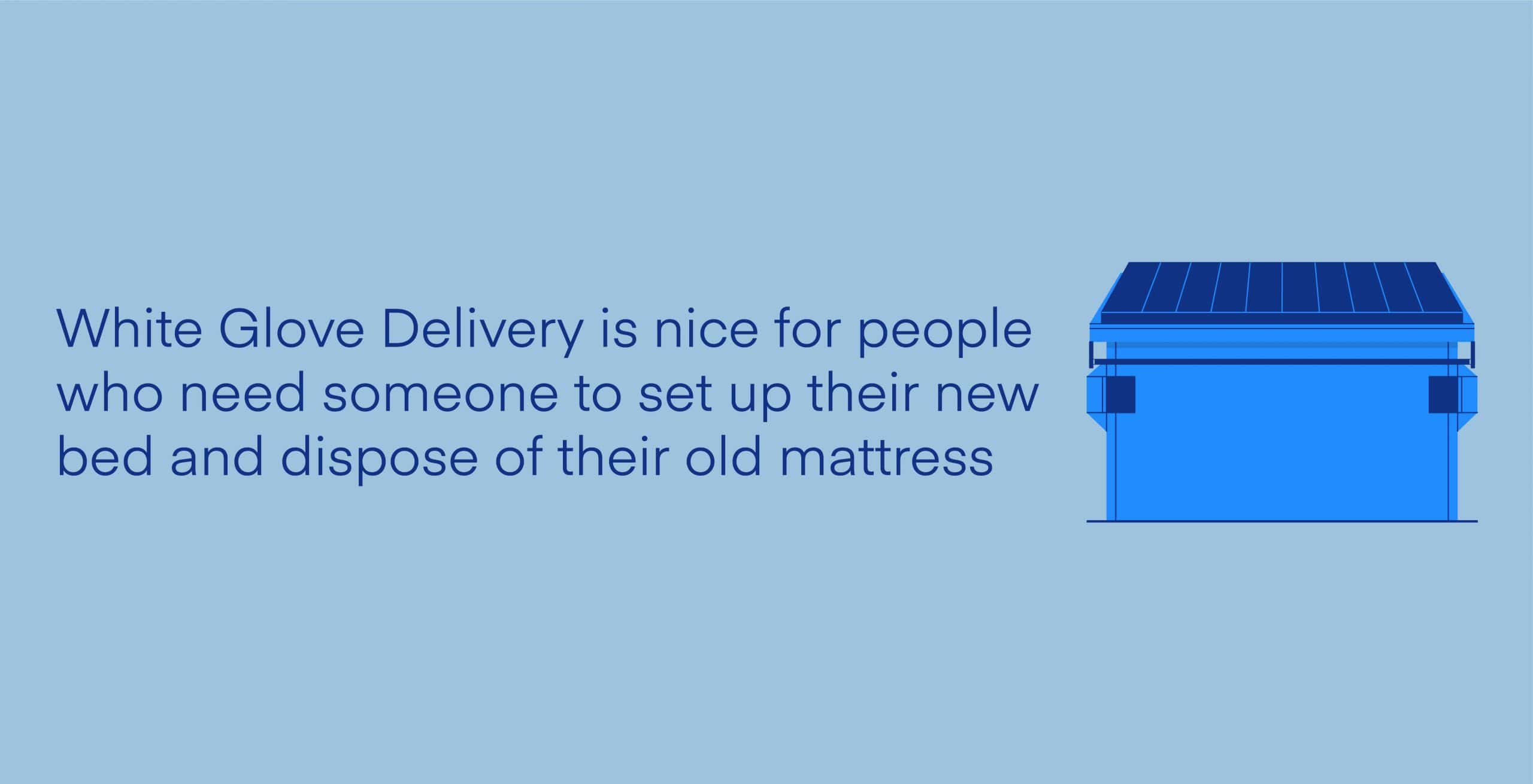
Latex beds cost more because they are extremely durable— latex mattresses have been known to last up to 15 years (most mattresses need replacing after 7-8 years max). Hybrids cost more because they use a combination of foam and springs— more materials translate to a higher cost.
Ultimately, a mattress with high value will be reasonably priced and backed up with a good warranty. It should also be made of high-quality, durable materials.
ILD Rating, Firmness, and Density
You may think that firmness, durability, and density are interchangeable, but when it comes to mattresses, they signify very different things. Knowing the difference between the three can help you choose a good mattress.
ILD Rating
ILD refers to Indentation Load Deflection and it measures mattress recovery time. Essentially, the ILD rating refers to the number of pounds of pressure needed to indent foam to a depth of four inches (or 25% of its height). A softer mattress will have a lower ILD rating, while a firmer mattress will have a higher ILD rating.
Note that the ILD rating only measures one layer, not the entire mattress, so while this number is helpful, it doesn’t give you the entire picture.
Firmness
Even though the ILD number tells you how much weight a layer of foam can sustain, this number is quite abstract and most companies don’t even advertise it on their website. A salesman in a mattress showroom might use it to confuse you, so it’s better to ask how about the mattress firmness on a simpler firmness scale.
Many mattress in a box brands use this scale to rate firmness because it’s easier for customers to understand. If you can’t find a comparable scale on a company’s website, contact their customer service for more information.
Firmness Scale Rating:
1: Very soft or plush, sinks deeply and easily.
2-3: Soft, surface sinks and conforms significantly.
4: Medium soft, surface sinks somewhat and conforms closely.
5: Medium, the surface doesn’t sink too much but still conforms.
6: Medium-firm, surface doesn’t sink too much but conforms a little.
7-8: Firm, surface does not sink hardly at all, minimal conforming ability.
9-10: Extra firm, no sinking or conforming.
Most beds in a box on the market today are between a 3-8 on the scale.
Density and Durability
The density of a layer refers to how tightly the material is compacted or compressed. Memory foam is naturally dense, although softer memory foams have more air channels, making them more easily compressible (compared to the base layers). You can measure density in pounds per cubic foot (PCF).
So what exactly does this number tell you? A foam with a higher PCF is more dense, making it more durable. This is why beds with softer foam comfort layers must have a denser core to extend the mattress lifespan.
A mattress with low-density foam on the top will break down much faster. Look for medium or high-density foams across all layers— while these mattresses will cost more, they will also last longer.
Remember: a firm mattress is not necessarily a more “durable” mattress. Durability is more nuanced and depends on the layer construction, mattress type, and even the warranty, as well as the density.
Sleeping Position
The way you sleep should influence the type of bed you buy— there is no “universally perfect” mattress because everybody has different needs and preferences. For example, a side-sleeper with lower back pain probably won’t enjoy a firm, solid bed. On the other hand, somebody with no chronic pain who prefers sleeping on their back would probably love a firmer bed.
Side Sleepers
Side sleeping is one of the healthiest positions because it keeps your spine in a relatively neutral posture while you sleep. A good-quality mattress should align your spine— and depending on your sleeping position, a too firm or too soft mattress may do the opposite.
Side sleepers, to keep their spines and shoulders in a healthy position, most often choose a medium to medium-soft mattress. While “medium” can have different meanings across brands, it usually translates into a bed with equal support and softness. On the firmness scale, a medium lies between 5.5 and 6.5.
Best mattress for side sleepers: memory foam, latex foam, or hybrid mattresses with soft foam layers.
Back Sleepers
Posture-wise, back sleepers have an advantage over other sleeping positions— they sleep in the best, most neutral position for the spine. Their weight is evenly spread across the mattress, decreasing the risk of paresthesia (numbing or tingling limbs), misalignment, or neck pain. For this reason, back sleepers typically like a medium-firm or medium mattress. One that sinks too far and collapses downward can cause pain.
Your weight also plays a part in the comfort level of your mattress— a heavier back sleeper will probably need a medium to thick mattress (12-14 inches) so they don’t feel the firmer, stiffer core layers when they lie down.
Best mattress types for back sleepers: memory foam, hybrid, latex, and some innersprings with conforming layers of foam.
Stomach Sleepers
We don’t recommend stomach sleeping because it comes with such a high risk of spinal misalignment, neck pain, and other issues. Stomach sleepers need to find a mattress with the exact right firmness, otherwise, they risk sinking down too far or their spine’s S-curve bowing upwards.
If you can’t seem to get out of the stomach-sleeping habit, try a firm, medium-firm or medium bed (note that some medium mattresses may feel too soft or cushioned for some stomach sleepers depending on weight). Additionally, your pillow should be low-loft (no more than 2-3 inches thick). Some stomach-sleepers sleep without any pillow at all to avoid the risk of neck pain.
Best mattress type for stomach sleepers: hybrids, innersprings, latex, and some memory foam (as long as the memory foam is firm to medium).
Combination Sleepers
Most of us fit in the combo sleepers category— even if you think you sleep in one position, most of us switch between at least two during the night. Most brands target their medium-feel mattresses to combo sleepers because it’s a perfect balance of firm and soft, accommodating most sleeping positions.
However, since “medium” doesn’t necessarily feel the same across different brands and mattress types, it’s best to take advantage of sleep trials or visit showrooms if you can.
Best mattress type for combination sleepers: memory foam, latex, hybrids.
Mattress In A Box Weight
Weight and body type can change the feel of a mattress completely. If you’re average-weight, you can trust that a “medium” mattress will feel medium, a “soft” will feel soft, and a “firm” will feel firm. However, if you’re lighter or heavier than average, the feel may fluctuate.
A heavyweight sleeper as defined by mattress brands weighs 230 pounds or more; if you fall into this category, choose a mattress that’s at least 12-13 inches thick so you don’t compress the softer layers and feel the stiffer core layer at the bottom. Additionally, because heavier sleepers sometimes compress the mattress up to 2 inches deep, they can choose a medium-firm or firm bed since these will feel softer than they do to the average sleeper.
Lightweight sleepers, on the other hand, will not compress their mattress much at all, and so depending on preferred sleeping position, they may like a mattress with softer cushioning. We suggest a medium, medium-soft, or soft bed for lighter sleepers.
Best mattress type for heavyweight sleepers: innerspring with a pillow top, hybrid, latex, memory foam with plenty of layers and varied firmness options.
Best mattress type for lightweight sleepers: hybrid with substantial foam comfort layers, latex, or memory foam.
Brand Reputation and Policies
As of the writing of this article, there are approximately 175 bed-in-a-box brands. That’s a lot of brands to sift through, much less to trust with your sleep health! Knowing potential red flags can give you peace of mind as you choose the best mattress.
Customer Service
The way a company treats its customers is so important that there are federally regulated organizations to protect consumers’ rights, such as the Federal Trade Commission. You can get a good idea of a company’s implementation of their customer service by reading reviews, but don’t take those at face value.
Brands will feature 5-star customer reviews at the forefront of their websites, but you should be able to find more critical reviews just as easily. Some brands provide a “filter” so you can sort reviews by concern or sleep position. Remember that negative reviews aren’t always about the mattress— some are about ease of returns, the warranty, and other company policies.
Obviously, you can’t try out every bed-in-a-box brand— there’s not enough time and frankly, that’s an exhausting endeavor (literally). Instead of trying every bed in existence, read reviews, read the return policies, read the Better Business Bureau reviews (if they are updated and available), and do a bit of light research on the brand itself.
If the company has been around for a while, they will probably have amassed quite a few reviews. However, if the brand is fairly new but they are advertising thousands and thousands of reviews, do some more digging.
Mattress brands have begun to sell their products on third-party websites such as Amazon— read reviews there, too. Better yet, if you know someone that’s been sleeping on a bed they got in a box, ask them if their sleep has improved (or worsened) since they got it.
Trial Period
The sleep trial period typically lasts at least 30 days to account for the break-in period you’ll need to get comfortable on your mattress. The average sleep trial is three times that long, allowing for ample time to decide if the mattress will work for you.
We’ve already mentioned customer satisfaction policies, which differ from sleep trials as they are only about one month long and therefore involve more risk. Mattress companies offering these in place of sleep trials often have a return policy requiring the customer to send back the bed themselves, unlike companies that come and pick up the mattress for you (or allow you to donate the bed).
We recommend you choose a brand with a hassle-free, risk-free sleep trial lasting at least 90 days.
Social Responsibility
While this isn’t a priority for some consumers, it can help you discern the strength of a company’s reputation. In particular, bed-in-a-box brands who use memory foam often get tested and certified for safety concerns. Remember, none of these certifications are required for a company to sell their mattress, so if they do take the extra time to ensure their foams are safe and green, that can be a good sign.
Since most memory foam is made using petroleum, some brands have begun to replace that crude oil with plant-based, environmentally-friendly oils instead. This practice minimizes potentially harmful emissions and the off-gassing smell that so often accompanies memory foam. Plant-based oils make the foam more breathable than traditional memory foam.
Other mattress brands certify their materials through third-party organizations. The most common “green” certifications you’ll see with mattresses include:
- CertiPUR-US® certified: Foams with this certification are made without ozone depleters, PBDEs, TDCPP, or TCEP (flame retardants), mercury, lead, other heavy metals, formaldehyde, phthalates, and low VOC emissions (volatile organic compounds). If you aren’t sure the company advertising a CertiPUR® certification is transparent, you can email info@certipur.us to ensure the brand is using the logo honestly. You can also search for companies using certified foam on CertiPur’s website (certipur.us).
- Greenguard Gold Certified: This certification means the product has been tested and scientifically proven to have low chemical emissions, such as VOCs.
- Oeko-Tex Certified: This certification applies to textiles, such as the cover or pillow-top of a mattress. It must be updated every year and the testing is done by third-party laboratories to eliminate any bias. Fabrics are thoroughly tested for harmful chemicals.
- GOTS or GOLS Organic: Organic certifications give peace of mind to the consumer, but they are not always comprehensive. For example, brands using fibers such as organic cotton, wool, bamboo, or flax have to be tested for synthetic fertilizers and pesticides to be labeled organic. However, they are not thoroughly tested for other harmful chemicals, like Oeko-Tex certified materials are. If you are worried about both pesticides and other harmful chemicals, look for Oeko-Tex certifications as well as GOTS certifications.
Best and Worst Mattress Types for Beds in a Box
While there are many mattress types to cater to every kind of sleeper, not every type will work well once it’s compressed into a box. That’s why most bed-in-a-box mattresses are foam.
Foam
So why is foam so popular anyway (besides the fact that it fits nicely in a box)? To put it simply: foam is comfy! It eases pressure points in the body, isolates motion (making it great for couples), and conforms closely to the body for the ultimate “cradled” feel.
Not all “foams” are the same: memory foam is our top recommendation because it has the best feel and is typically higher quality than other types. If you’re concerned about sleeping hot, choose gel-infused foams to dissipate body heat.
Gel-Infused
Because memory foam is pretty dense, it naturally traps heat. This is great news for cold sleepers, but not so much for those who like to keep a more even temperature while they sleep. To combat this, many companies now make their foams with cooling gel or copper infusions— materials that draw heat away from the body and the mattress.
As if this wasn’t already confusing, there are different types of gel-foam as well. The most common is gel-infused foam, where gel is transformed to a liquid state and mixed in with the foam during manufacturing. Some companies use gel beads as well, but these are not always effective.
Other cooling materials infused into foam include copper, graphite, and charcoal.
Bottom line: good for beds in a box? Yes.
Poly-Foam
Poly-foam (short for polyurethane foam) is similar in feel to memory foam, but it’s much cheaper and it breaks down faster. If you need a mattress for just a short period of time, poly-foam is a good option because it’s a cost-friendly, albeit short-lived option. Innerspring beds often employ poly-foam in the top layers, which may account for the rapid sagging rate of innersprings.
Poly-foam can be CertiPUR-US® certified, but it does not usually have the other certifications that many memory foam brands do. If you’re looking for a hypoallergenic, green option, memory foam is probably a safer bet. Memory foam is also more pressure-relieving than poly-foam by virtue of its viscoelastic properties.
Bottom line: good for beds in a box? Yes.
Memory Foam
Memory foam is also known as viscoelastic polyurethane foam— the difference between this and poly-foam is the “viscoelastic” characterization. Unlike poly-foam, memory foam has added materials making it viscous and elastic upon contact with heat and pressure. In other words, it’s softer, more contouring, and relieves pressure much better than poly-foam does.
Memory foam sinks easily, which is why a long-lasting memory foam mattress needs to have a sturdy support core. The ILD rating of foam can tell you how durable a mattress is, but remember that firmness is not the same thing as durability or density.
Memory foam isn’t known for its edge support, so if this is a concern for you, look for memory foam beds with reinforced edges.
Bottom line: good for beds in a box? Yes (one of the best types for beds-in-a box).
Innerspring
Innerspring beds are the traditional mattress you most likely grew up sleeping on. They are bouncy and can feel quite comfortable at first, but they break down fairly quickly compared to other mattress types. Innersprings are naturally cooler than foam because of their coil construction, but they don’t offer as much pressure-relief as foam, nor do they isolate motion as well.
Because innerspring mattresses use steel coils as their primary layer, they are not usually sold by “bed in a box” brands. Compressing and rolling an innerspring would most likely ruin it; at the very least, it would cause damage to the coils, negating any support they could offer.
Bottom line: good for beds in a box? No.
Latex
Latex feels similar to memory foam, but it is extremely durable as well as eco-friendly (as long as it’s natural, not synthetic or blended latex). Some latex beds can last up to 15 years (that’s about 5-6 years longer than a good memory foam mattress lasts).
Natural latex is harvested from the sap of a rubber tree— rubber trees are usually grown on sustainable plantations. Rubber trees can be used for up to 25 years, reducing waste. Additionally, harvesting the sap from rubber trees does not harm them.
Latex is usually made using two different methods: Talalay and Dunlop. Neither one is more eco-friendly than the other, but they produce a slightly different feel. Talalay is softer and you will usually find it in the top comfort layers of a latex bed. Dunlop is firmer and bouncier, so it’s often used in the transition or core layers.
If you’re looking for an environmentally-friendly, durable option that’s similar to foam, try latex. It does have a bouncier feel than memory foam, but some people prefer that. Many latex beds are also aerated, making them slightly more cooling than memory foam.
Bottom line: good for beds in a box? Yes.
Hybrid
Hybrids combine the coil core of an innerspring bed with the plush comfort layers of a memory foam bed. A hybrid must have at least 2-3 inches of foam to be considered a hybrid— and most have even more than that. Hybrids are a good middle ground mattress for anyone who prefers the bouncy support of innerspring coils, but also needs pressure relief from the foam top layers.
What’s more, hybrids use pocketed coils, meaning each coil is wrapped in fabric to minimize motion transfer.
Hybrids can be compressed and rolled into a box and many bed-in-a-box brands sell hybrid models, but only certain types of coils can go through this process without sustaining any damage. This is why most hybrid beds-in-a-box have flexible coils in their base.
Bottom line: good for beds in a box? Yes, but be wary of “cheap” hybrids that can be easily compressed but offer little support thanks to their flimsy, thin coils.
Read More: Best Hybrid Mattress Guide
Pros and Cons of Mattresses in a Box
Beds in a box can seem too good to be true, and some are— that’s why looking at every mattress type, the layer construction, and the manufacturing process will give you a better idea of the mattress quality.
| PROS | CONS |
| Most come with risk-free sleep trials | Compressing certain mattress types into a box dampens their quality |
| Cost-cutting (they eliminate the overhead costs and inflation common in brick-and-mortar mattress stores like Mattress Firm) | Not all come with generous sleep trials or warranties |
| Many beds in a box are comfortable and long-lasting | Some companies charge you restocking or shipping fees to return the mattress |
| Most have easy returns | You can’t try out the bed before you buy it (but most sleep trials eliminate this risk) |
| They ship directly to your door | |
| Easy set-up |
Who Should Buy Beds in a Box?
At this point, you might be wondering if anyone wouldn’t enjoy a bed in a box. They’re convenient, many are high quality, and they are often less expensive than the same quality bed you’d find in a showroom.
One study published in 2011 found that consumers who tested out mattresses in a showroom did not choose a comfortable bed and their sleep did not improve. They concluded that the best way to test out a mattress is to try it overnight— in other words, customers need some kind of sleep trial to ensure their new mattress really is the best for them.
Of course, beds-in-a-box are not completely without risk. Perhaps the bed is comfortable all through the sleep trial, but it starts to feel different after you’re outside the return window. Some companies offer a foam topper for added comfort, but not all do. That’s why it’s crucial to research the sleep trial length, mattress materials, and read unbiased reviews (these are harder to find than you might think).
FAQs
How much does an Amerisleep mattress in a box cost?
Our eight mattress models range in price from $909 to $1679 (based on queen sizes). Each mattress also comes with free shipping, a 100-night sleep trial, and a 20-year warranty.
Who is Amerisleep?
At Amerisleep we strive to deliver better sleep by educating our customers on the importance of good sleep and connecting them with a comfortable mattress for their specific needs.
We make and sell eight mattresses in total: five memory foam mattresses and three hybrids. Instead of designing our mattresses on a “Good, Better, Best” model, we engineer our beds for varying sleep needs. Our eight mattresses range in firmness and are tailored towards different sleep styles and preferences.
All of our mattresses are made right here in the United States and feature eco-friendly plant-based foam. Instead of using traditional memory foam in our beds, each of our mattresses contains Bio-Pur®, plant-based memory foam. Using eco-friendly foams are not only better for your health, but easier on our environment. We also reduce our impact on the environment by using recyclable cardboard packaging and responsibly recycling any returned mattresses that cannot be locally donated.
Is there a warranty for Amerisleep mattresses?
We back each of our mattresses with a 20-year warranty covering manufacturing defects and sags greater than .75 inches. Please note, our warranty does not cover normal wear and tear.
For the first 10 years of our 20-year warranty agreement, we will repair or replace a defective mattress for free. In the second 10 years of our warranty, we will replace your mattress at a 50% discount.
Does an Amerisleep mattress in a box sleep hot?
Memory foam mattresses have a tendency to sleep hot, which is why we design our mattresses with temperature regulation in mind. Our proprietary Bio-Pur® foam has an advanced open-cell structure, making it more porous and breathable than traditional memory foams. Instead of trapping heat within, Bio-Pur’s® structure dissipates warm air out of the mattress to keep you sleeping comfortably.
We also incorporate HIVE® technology within our memory foam mattresses to aid in temperature control. While HIVE® primarily functions as a zoned support system, its hexagonal cutouts create air channels within the transition layer of foam, resulting in clear passageways for hot air to escape out of the mattress.
What size mattress can ship in a box?
We ship all of our mattresses, from twin to California king sizes, compressed and rolled up in a 16”x16”x44” box. Our split-king mattresses are shipped in two boxes (both of which have those same dimensions).
Are there shipping costs for an Amerisleep mattress in a box?
We ship out mattresses free of charge via FedEx. Our mattresses are delivered direct to your doorstep so they can easily be brought inside for setup. Plus, through our sleep trial, we also offer free returns and exchanges (should you find your mattress is not a fit).
Is a Bed in a Box Right For You?
At the end of the day, the “best” mattress for you will most likely be different than the one your mom or your best friend likes. Thankfully, if you want to try out the new bed-in-a-box trend, there’s plenty of options to suit every sleeping style, budget, and health concern. The trick is knowing what to look for and where to look for it so you can get a good night’s sleep.
About the author
McKenzie Hyde is a Certified Sleep Science Coach and a full-time writer focused on sleep health and the mattress industry. She currently writes articles on a variety of topics, ranging from sleep hygiene to the newest trends in the mattress and bedding industry. Just some of the topics she has covered include best sleep practices for students, the consequences of going without sleep, and choosing the right bed if you suffer from back pain. McKenzie Hyde holds a Master of Arts degree from Utah State University where she studied literature and writing. While there, she taught argumentative writing and wrote a variety of articles and analyses for literary and academic journals.
View all posts